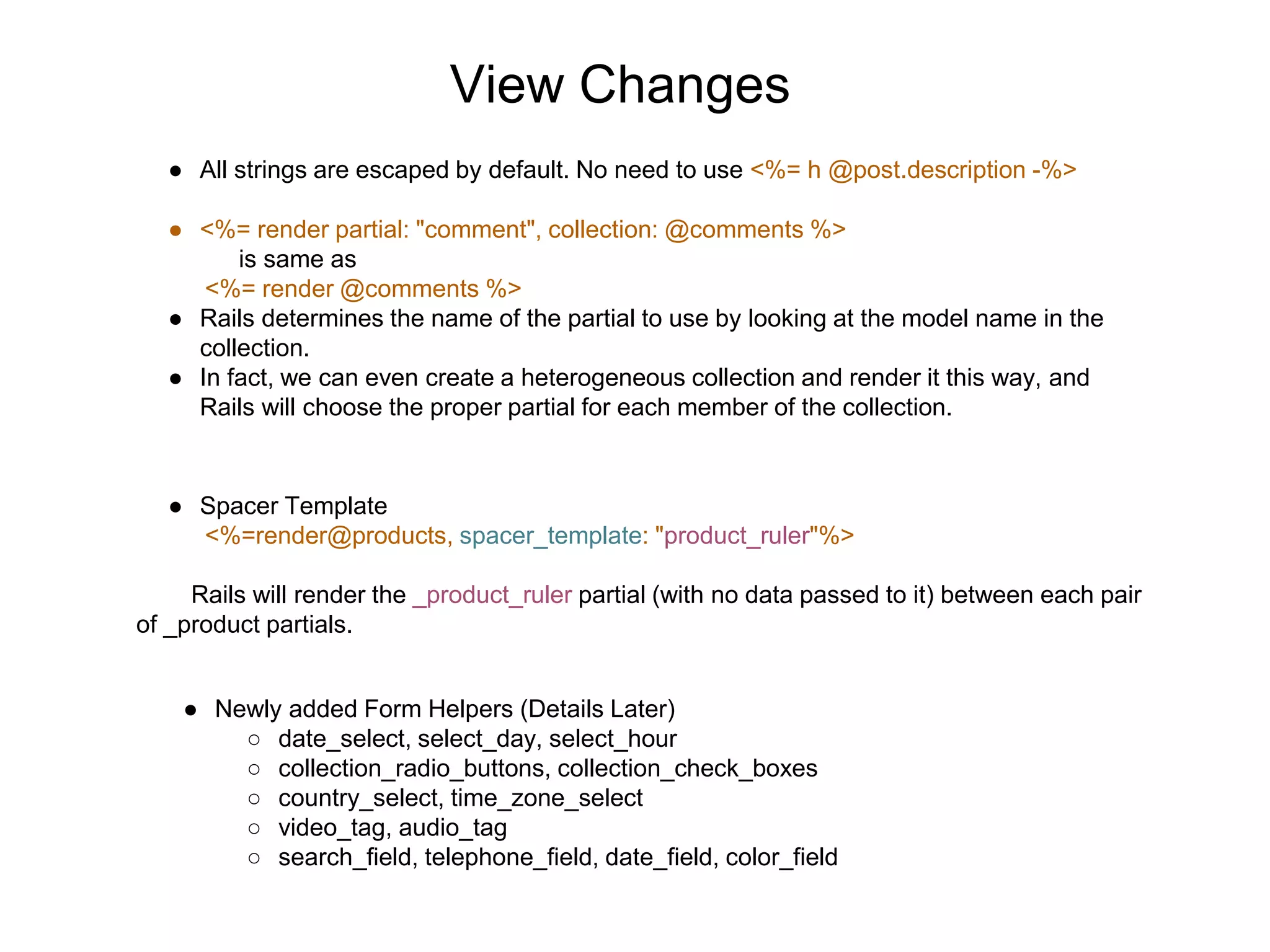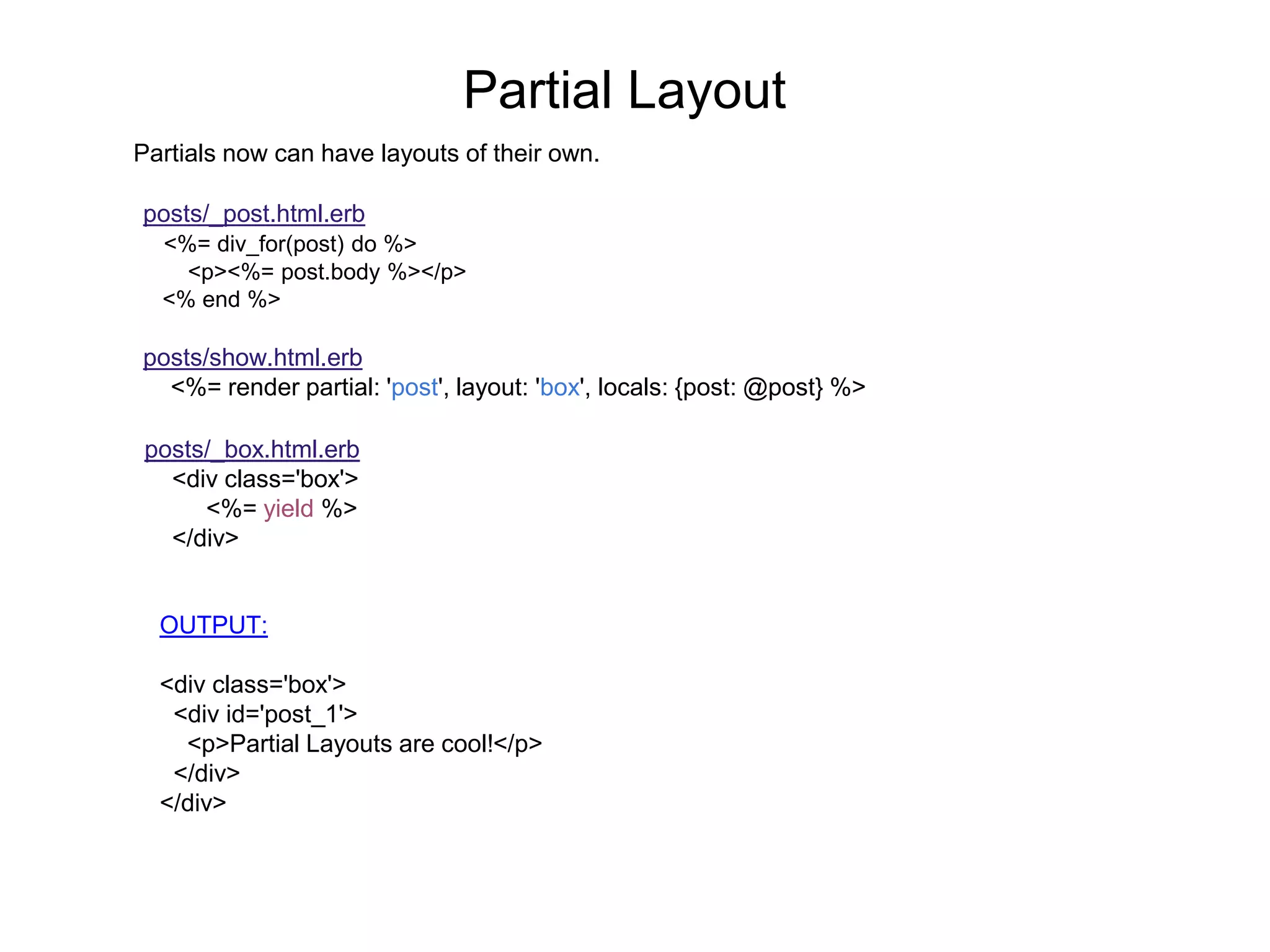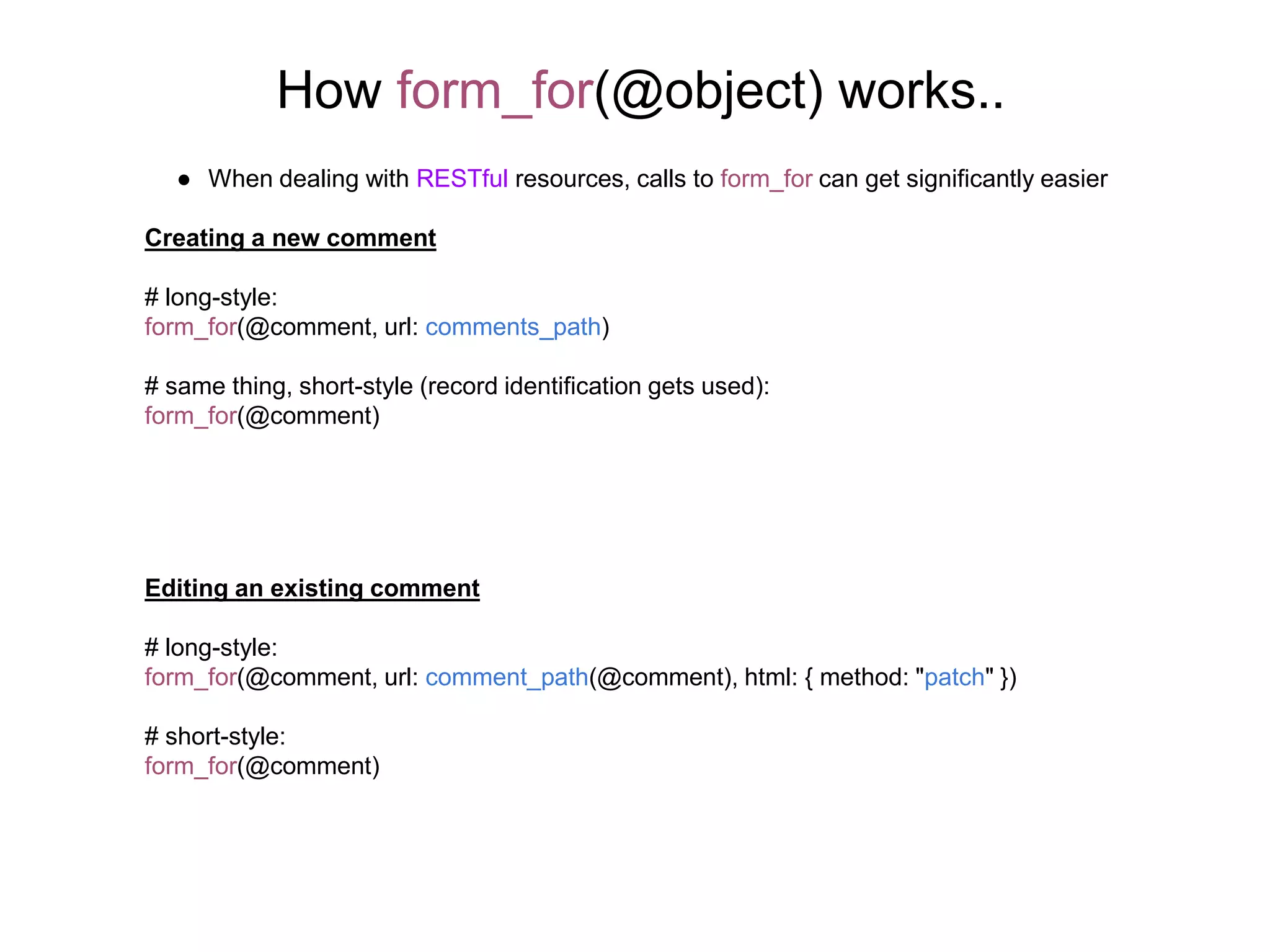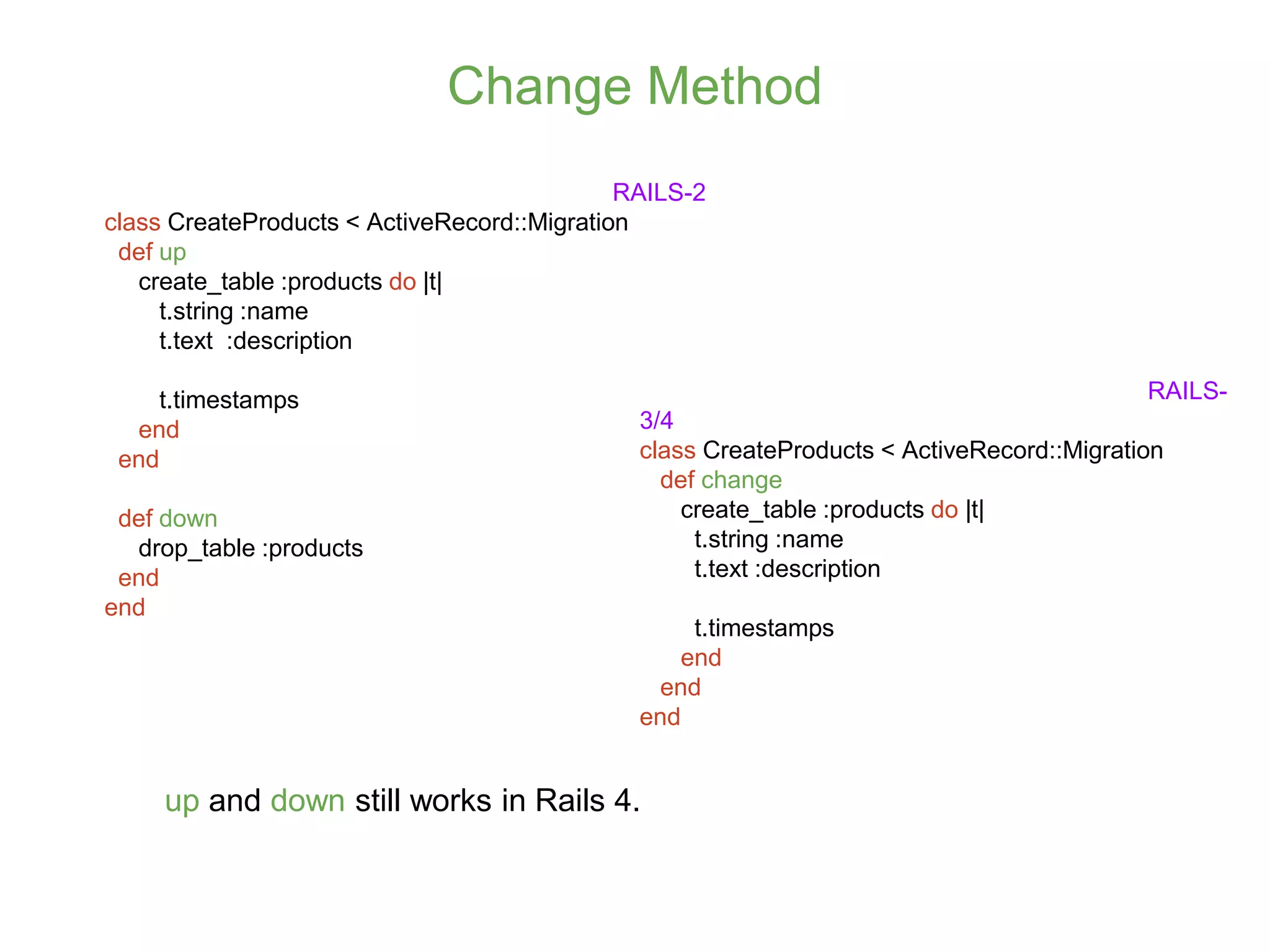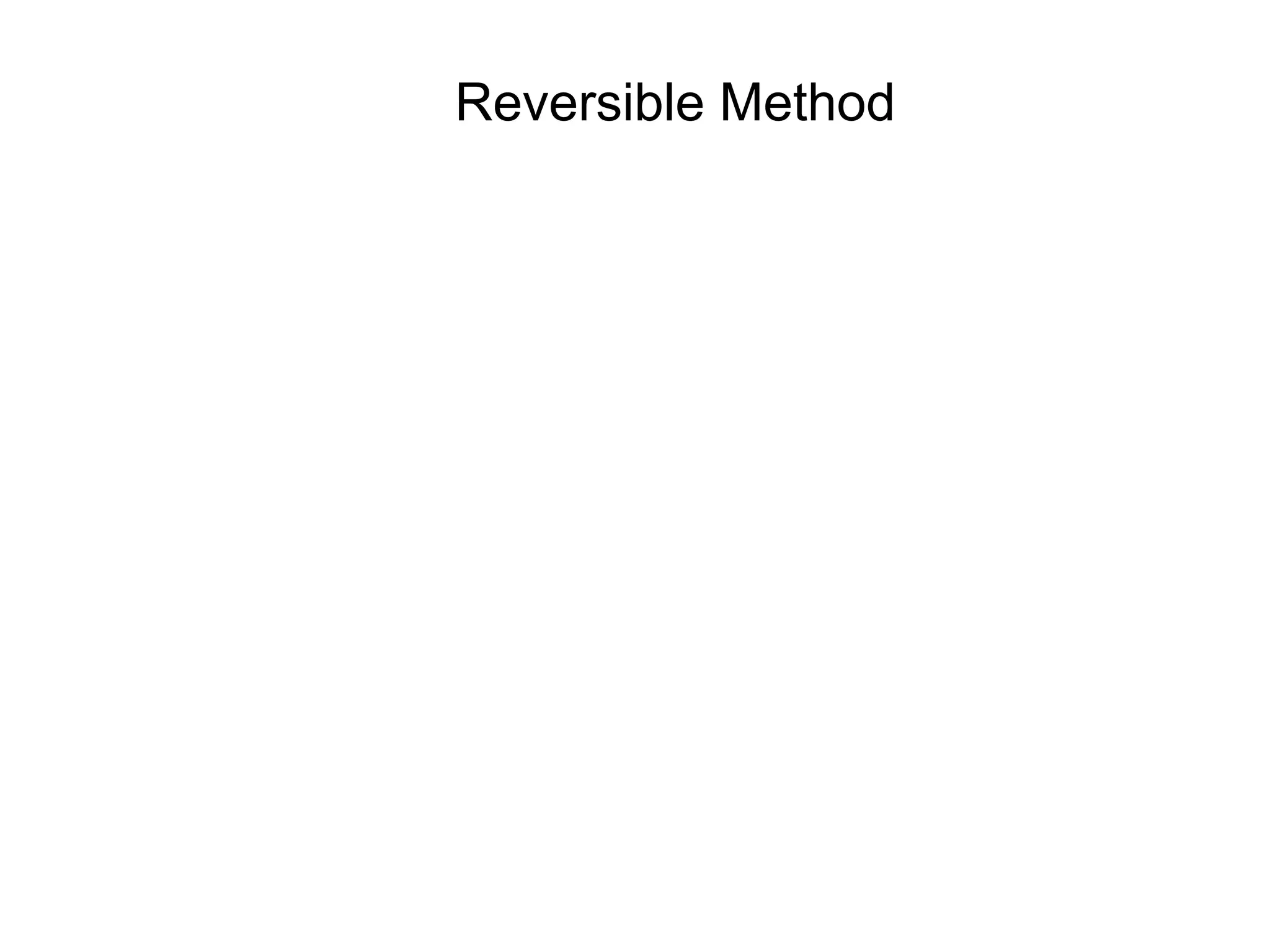This document provides an introduction and overview of key changes between Rails 3 and Rails 4. It discusses changes to components like ActiveRecord and ActionPack. It outlines changes to models, including the introduction of AREL and concerns directories. Controller changes like strong parameters and view changes like new form helpers are reviewed. Routing changes such as PATCH verbs and constraints are covered. Finally, migration and turbolinks additions are summarized.


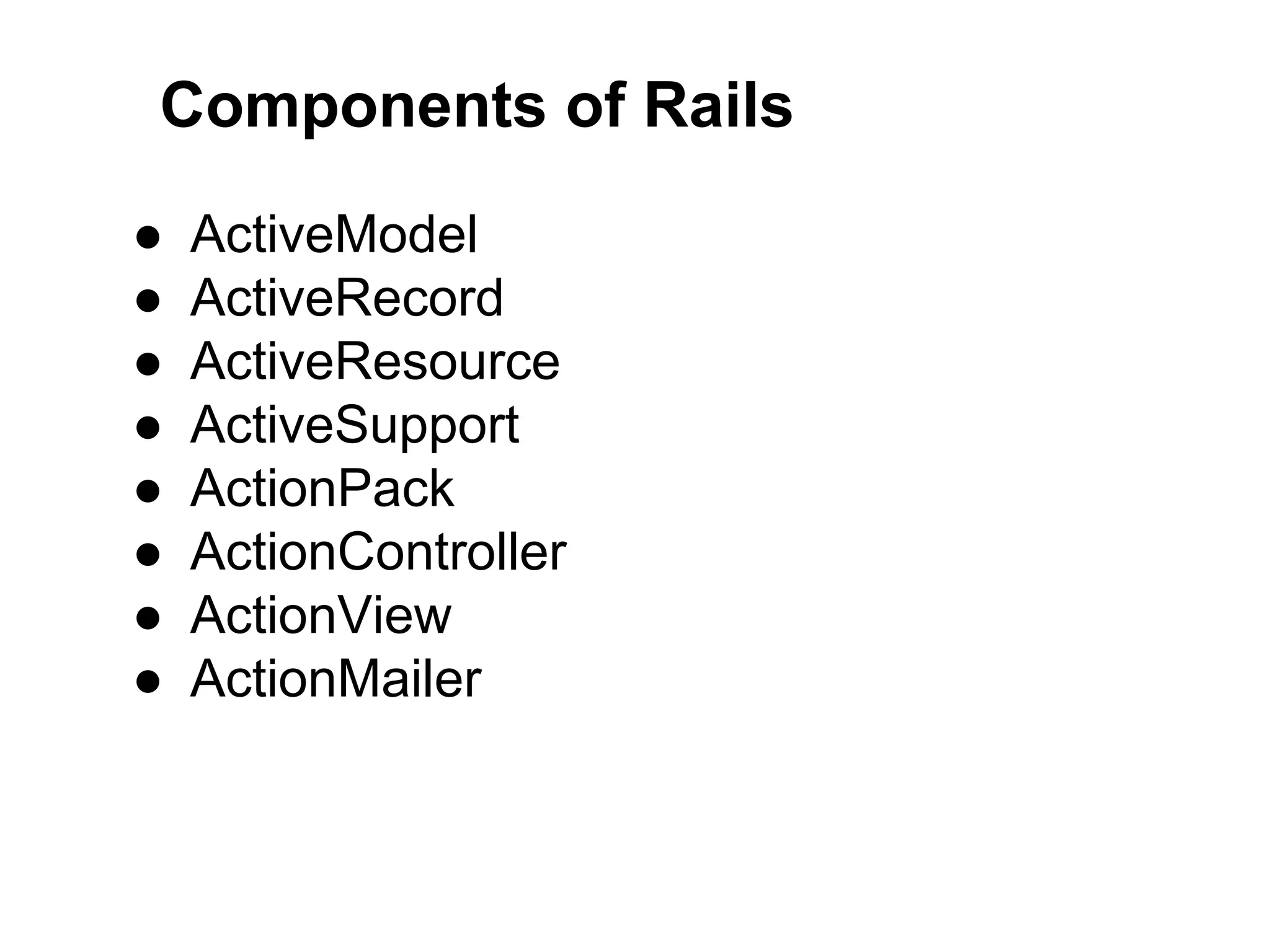

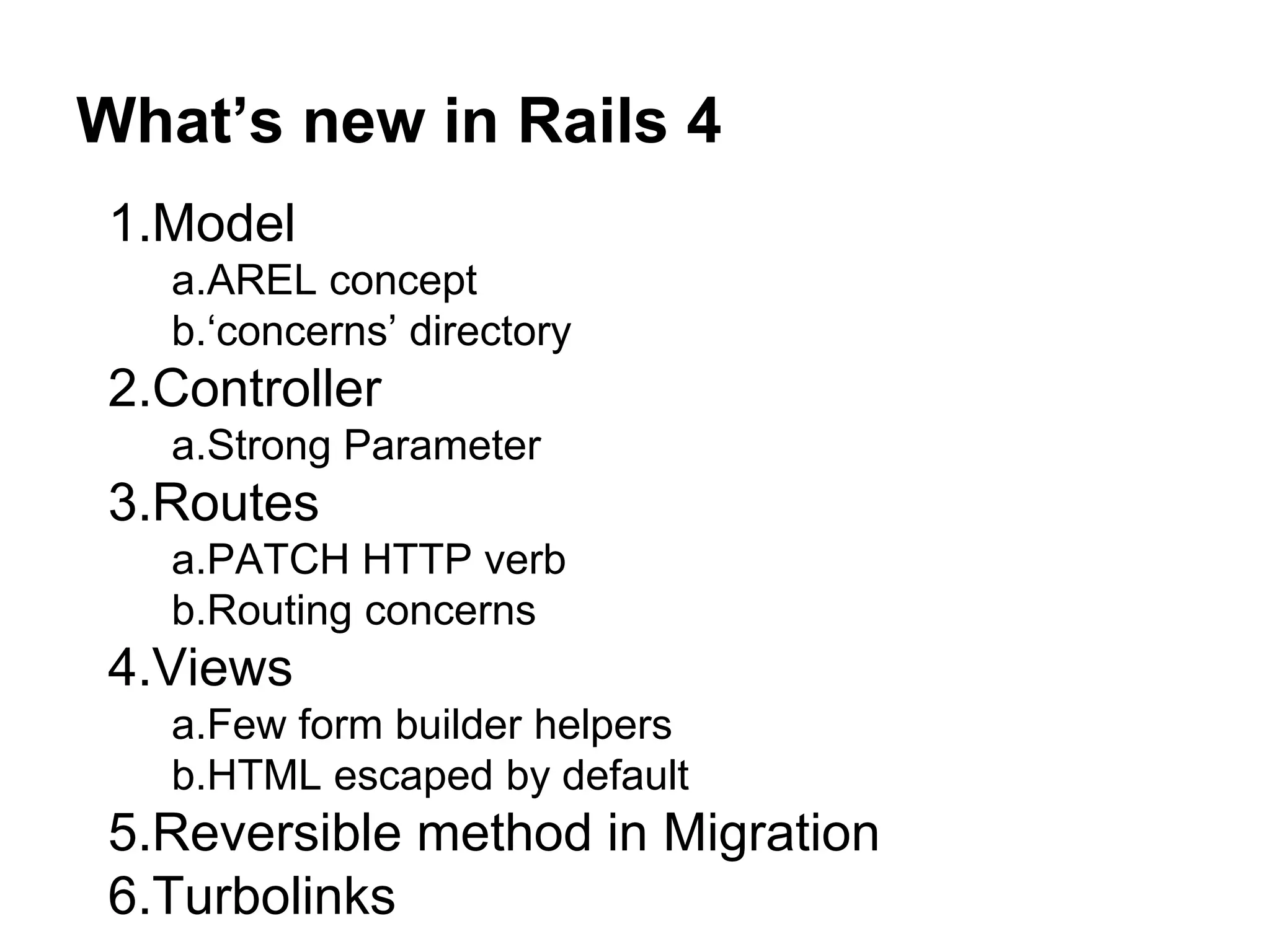
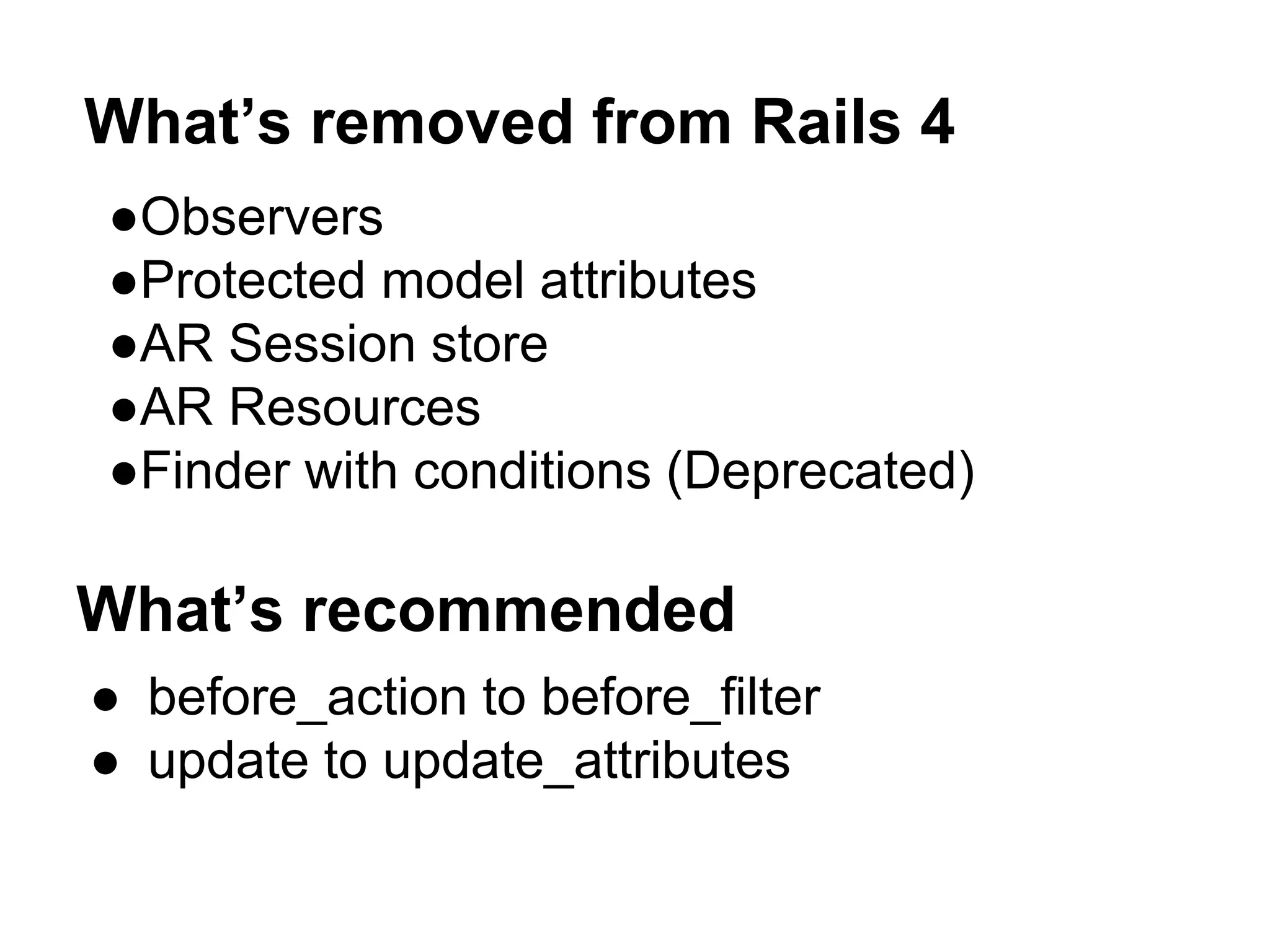

![Validation RAILS-2 class User validates_acceptance_of :terms_of_service validates_associated :books validates_format_of :email, :with => /A[a-zA-Z]+z/, :message => "Only letters allowed" validates_presence_of :login, :name, :address validates_exclusion_of :subdomain, :in => %w(www us ca jp) end RAILS-4 class User validates :terms_of_service, acceptance: true validates_associated :books validates :email, format: {with: /A[a-zA-Z]+z/, message: ‘Only letters allowed’} validates :login, :name, :address, presence: true validates :subdomain, exclusion: {in: %w(www us ca jp)} end](https://image.slidesharecdn.com/dfba88c1-b011-4812-a093-a962160ae1fb-161112134017/75/Intro-to-Rails-4-8-2048.jpg)
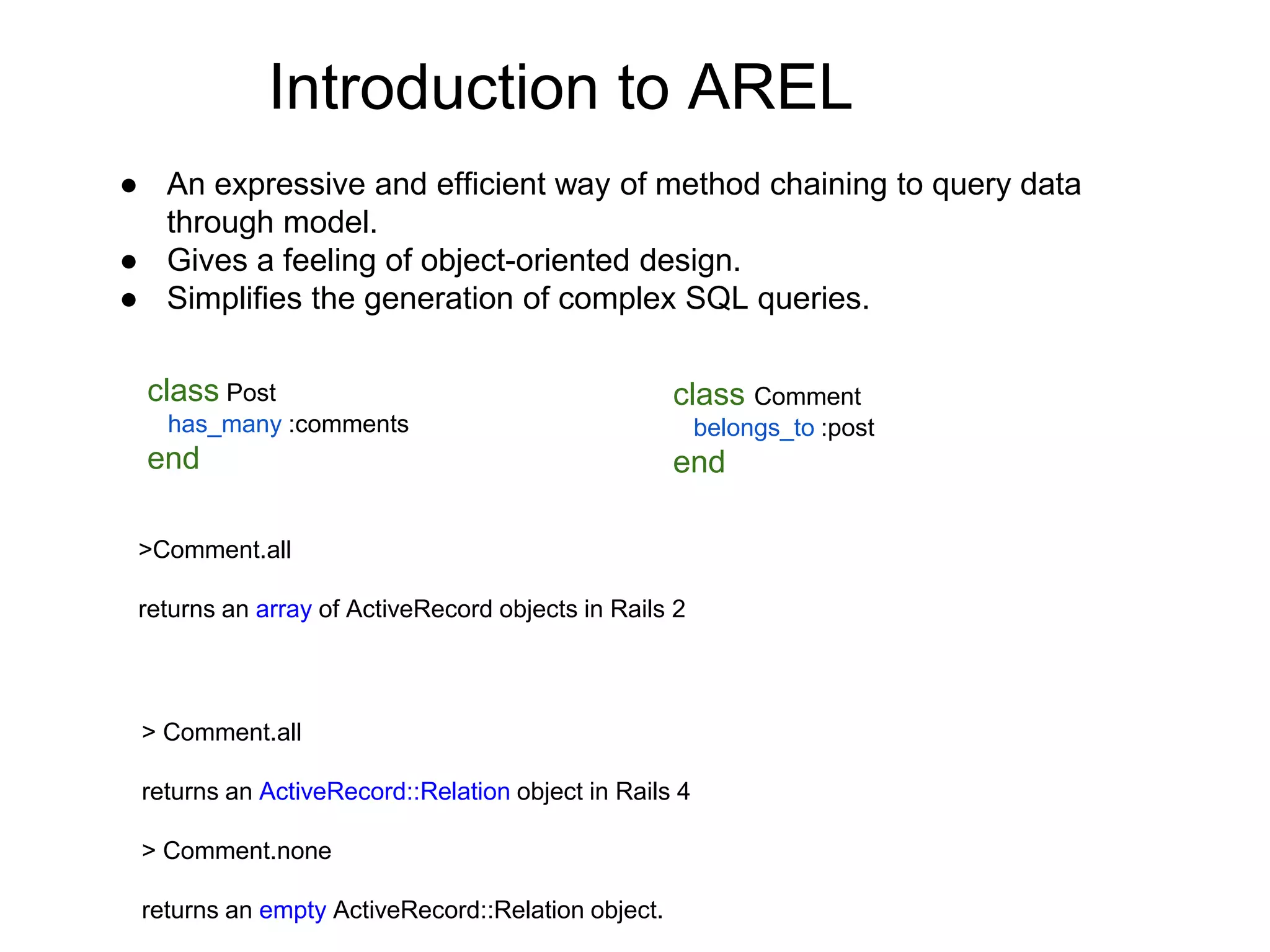

![ActiveRecord Finders RAILS-2 Comment.find(:all, :conditions => {:commenter => nil}) There are many finder methods defined in ActiveRecord to retrieve objects from the Database, such as: where, group, having, offset, take, limit, joins, includes, order, readonly, select etc. Each of these methods returns an instance of ActiveRecord::Relation class. RAILS-4 Comment.where(commenter: nil) Comment.find(:first, :conditions => [‘commenter IS NOT NULL’], :order => ‘created_at DESC’) Comment.where.not(commenter: nil).order(“created_at desc”).first Comment.find_all(:conditions => [‘commented_at >= ?’, 2.days.ago], :limit => 5) Comment.where(“commented_at >= ?”, 2.days.ago).limit(5) Comment.find_by_commenter(“Tukuna”) Comment.find_by_comenter(“Tukuna”) Post.find(:all, :conditions => [“likes_count > ?”, min_likes], :include => :comments) Post.where(“likes_count > ?”, min_likes).includes(:comments) Comment.find(:first, :order => “commented_at DESC”) Comment.order(:commented_at).last Comment.find_by(commenter: “Tukuna”, body: nil)](https://image.slidesharecdn.com/dfba88c1-b011-4812-a093-a962160ae1fb-161112134017/75/Intro-to-Rails-4-11-2048.jpg)
![Finders Continues.. ● Model.take retrieves a record without any implicit ordering. Returns nil or array of AR objects. Comment.take => #<Comment id: 1, commenter: "Lifo"> Comment.take(2) =>[#<Comment id: 1, commenter: "Lifo">, #<Comment id: 3, commenter: "Donald">] ● Model.limit also retrieves records without any ordering. But it takes an arg and returns ActiveRecord::Relation object Comment.limit(2) => #<ActiveRecord::Relation [#<Comment id: 1, commenter: "Lifo">, #<Comment id: 2, commenter: "Donald">]> ● Model.first finds the first record ordered by the primary key. Also takes argument (e.g: Comment.first(10)) ● Model.last finds the last record ordered by the primary key. ● Model.find_by finds the first record matching some conditions. Comment.find_by(first_name: 'Lifo') => #<Comment id: 1, commenter: "Lifo"> Comment.find_by_first_name(‘Donald’) => #<Comment id: 2, commenter: "Donald"> Model.find_all_by_… method is deprecated](https://image.slidesharecdn.com/dfba88c1-b011-4812-a093-a962160ae1fb-161112134017/75/Intro-to-Rails-4-12-2048.jpg)
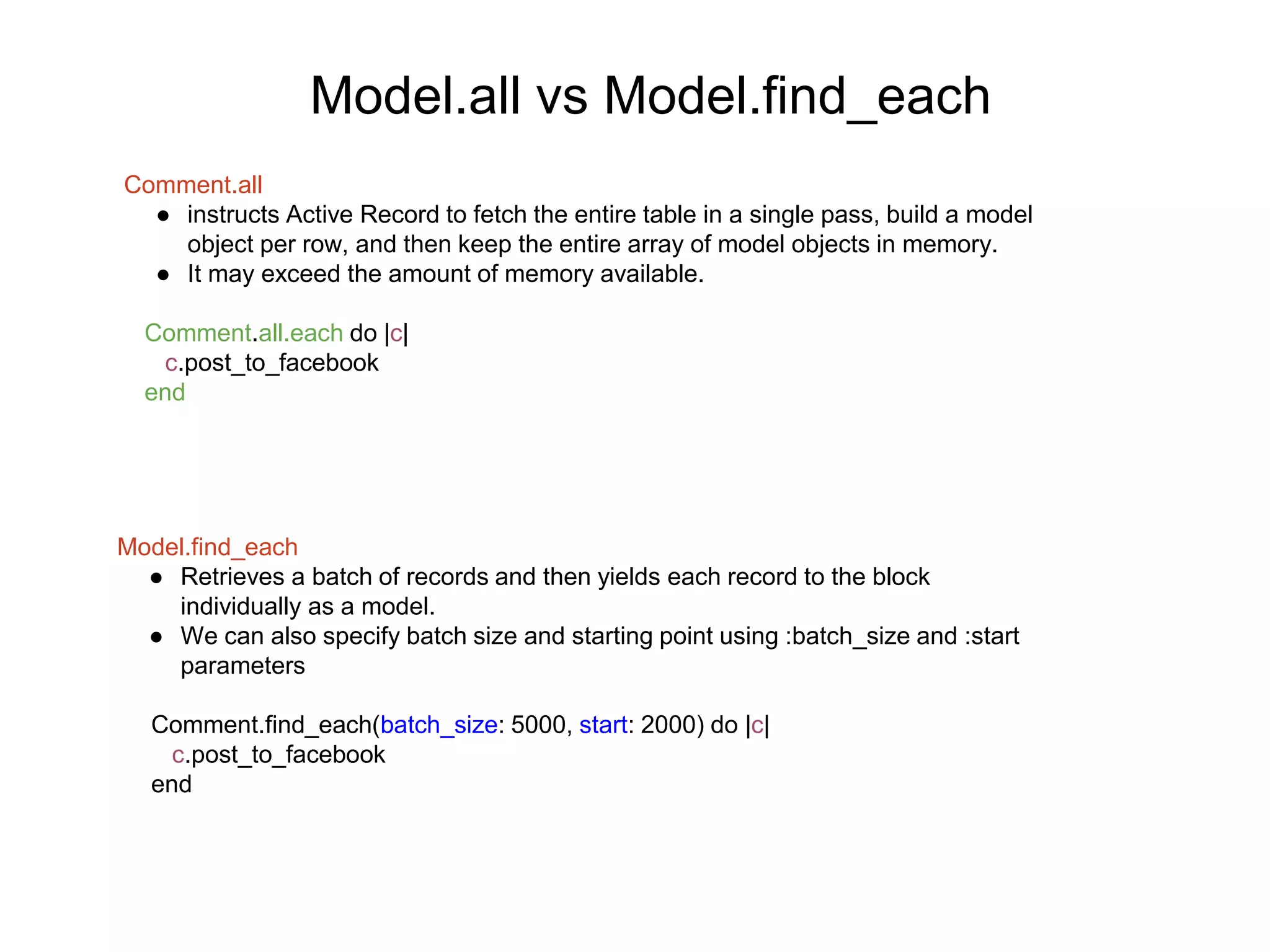
![Scopes RAILS-2 class Comment named_scope :recent, :conditions => [“created_at > ? AND created_at < ?”, 2.days.ago, Time.now] named_scope :published, :conditions => { :state => :published } named_scope :published_after, lambda { |time| { :conditions => [“published_at > ?”, time] } } end RAILS-4 class Comment scope :recent, -> { where(“created_at > ? AND created_at < ?”, 2.days.ago, Time.now) } scope :published, -> { where(state: :published) } scope :published_after, -> (time) { where(“published_at > ?”, time) } end All scope methods will return an ActiveRecord::Relation object which will allow for further methods to be called on it. But why? If server has started 5 days ago then this 2.days.ago would give value equal to 7.days.ago This has been rectified in Rails-4 using lambda syntax: scope :published, -> { where => {'created_at >= ?', 1.day.ago} } This runs at run-time not class loading time.](https://image.slidesharecdn.com/dfba88c1-b011-4812-a093-a962160ae1fb-161112134017/75/Intro-to-Rails-4-14-2048.jpg)
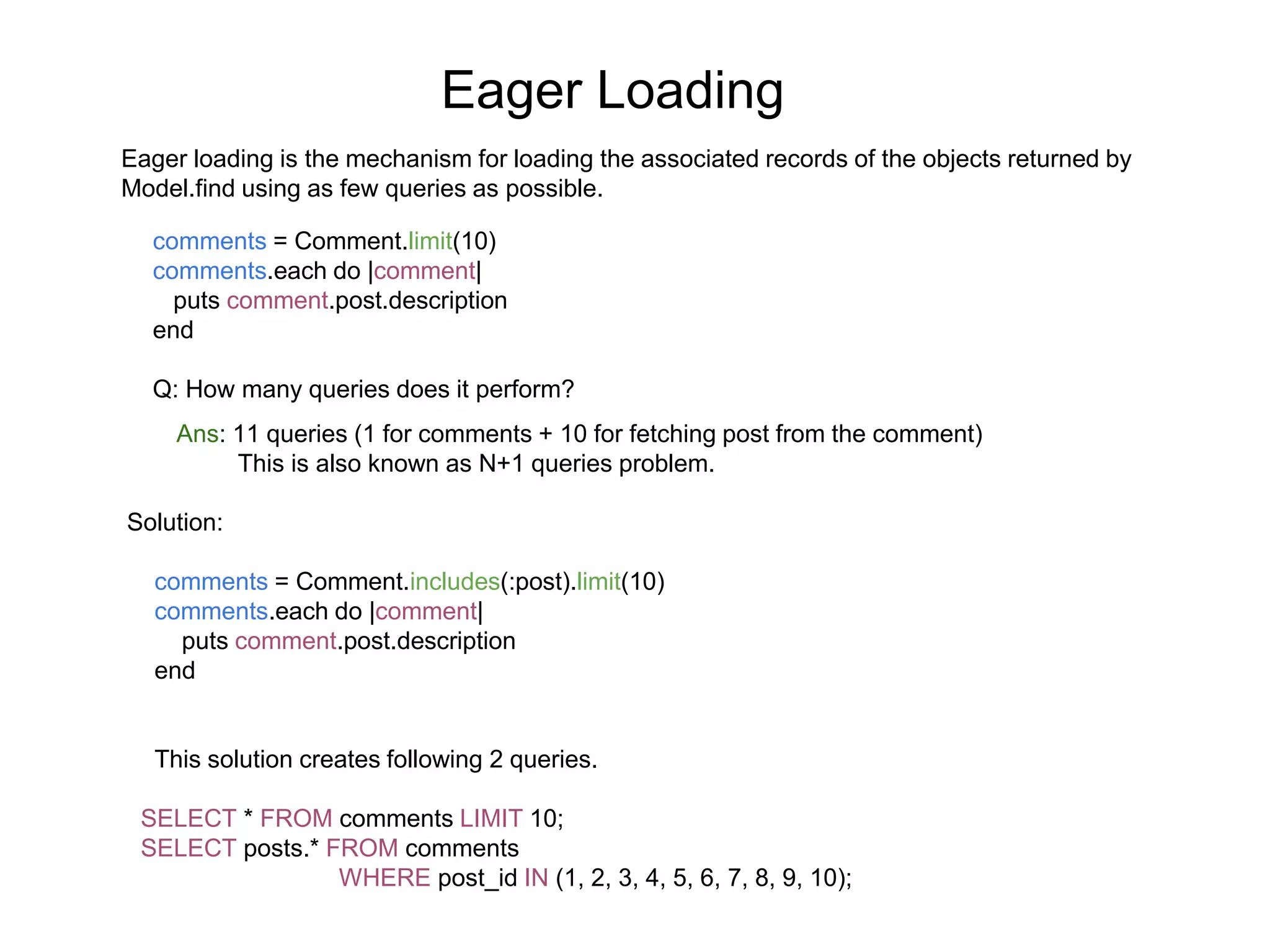

![Controller Changes ● Sessions are lazily loaded. If you don't access sessions in your action's code, they will not be loaded. Hence you will never need to disable sessions, just not accessing them will do the job ● application.rb file is renamed to application_controller.rb ● before_action should be used in place of before_filter Flash Message Can assign a flash message to :notice, :alert or :flash as part of the redirection. redirect_to post_url, notice: “Message is successfully created." redirect_to post_url, alert: "You're stuck here!" redirect_to post_url, flash: { referral_code: 1234 } <p class=”notice”> <%= flash[:notice] %> </p> X <p class=”notice”> <%= notice %> </p>](https://image.slidesharecdn.com/dfba88c1-b011-4812-a093-a962160ae1fb-161112134017/75/Intro-to-Rails-4-17-2048.jpg)
![Strong Parameters ● With strong parameters, Action Controller parameters are forbidden to be used in Active Model mass assignments until they have been whitelisted. ● The basic idea is to move mass-assignment protection out of the model and into the controller where it belongs. class CommentsController < ApplicationController def create @comment = Comment.create(params[:comment]) end ………… end This will raise an ActiveModel::ForbiddenAttributes exception. class CommentsController < ApplicationController def create @comment = Comment.create(comment_params) end ………… private def comment_params params.require(:comment).permit(:commenter, :body) end end NOTE: comment_params is private. This new approach prevents an attacker from setting the model's attributes by manipulating the hash passed to the model.](https://image.slidesharecdn.com/dfba88c1-b011-4812-a093-a962160ae1fb-161112134017/75/Intro-to-Rails-4-18-2048.jpg)
![Nested Parameters (Skip) params.permit(:name, { emails: [] }, friends: [:name, family: [:name], hobbies: [ ] ]) This declaration whitelists the name, emails and friends attributes. It is expected that ● emails will be an array ● friends will be an array of resources with specific attributes ○ a name attribute ○ a family attribute which is restricted to having a name ○ a hobbies attribute as an array](https://image.slidesharecdn.com/dfba88c1-b011-4812-a093-a962160ae1fb-161112134017/75/Intro-to-Rails-4-19-2048.jpg)

